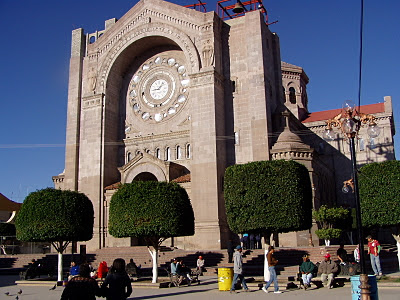Matehuala is a 4 hour bus ride from Monterrey and Monterrey is a 4 hour bus ride from home. I got to Matehuala without a hotel reservation and without a city map. I knew the streets I was searching, but could not tell north from south. It turns out that the location of the city bus station, based on Google Earth, was incorrect. The new one was built on the other side of town.
I asked someone at the bus terminal to recommend a hotel and she said, "Hotel del Parque." She did not suggest another in the center of town. After the 33 peso cab ride, I got to the hotel. It was perfect. There was an elevator and they accepted credit cards.
Hotel del Parque (Hotel by the Park)
The hotel is across the street from a park. The hotel is modern in every way. There was a computer with Internet access in the lobby for guests. There was a nice restaurant, and the rooms were spacious. The $55 a night were worth it.
The central location was a plus. It was 3 blocks from the church and the market place, "El Mercado." One of the streets on my list of things to find was a block away, and the cemetery was two blocks away.
The clerk at check-in said, "Your room is 109, on the first floor." I asked for directions from the desk and she said, "Well you can take the elevator or the stairs to the first floor and then follow the signs." I was there three nights and I still had trouble remembering that the ground floor was not the first floor.
 The park was quiet in the morning with only a few walkers. By 5 pm there were many people out and about - walking, sitting, hugging and kissing. In Mexico, parks are a good place to meet up with your boyfriends/girlfriends on your way to school or home from school. All the parks in the city, that I aw, had an old fashion bandstand in the center - wrought iron and tin roof.
The park was quiet in the morning with only a few walkers. By 5 pm there were many people out and about - walking, sitting, hugging and kissing. In Mexico, parks are a good place to meet up with your boyfriends/girlfriends on your way to school or home from school. All the parks in the city, that I aw, had an old fashion bandstand in the center - wrought iron and tin roof.The mercado is in the center of town. It is the place to go for vegetables, meats, fish, etc. Surrounding the mercado are many other shops. The three pictures below are examples.
This one sold pretty much what was in the mercado. This facade was more appealing. Inside the shop was crammed with the same items. Keep in mind that these items are not necessarily tourist souvenirs. The pottery and bird cages are kitchen/ household items.
The FarWest shop repaired and sold hats. I wish I knew where they came up with the name.
This shop sold fake flowers, candy, and more. Are you getting a better deal at the 3 and 10 than at the 5 and 10?
You see street lamps like this throughout the city. Not all were as nicely painted as this one outside the cathedral. Others were rusty, but functional. I liked them.
Another city park. There were many green spaces in the city. I spoke with one of the park sweepers and found out how much he values his job. He said that he had been working for the city for about 10 years and had no thoughts of quiting or looking for another job. He said that the average job pays 60 pesos/ week. His city job, as a park sweeper, pays 110 pesos/ week.
City Streets
The Othon Theater
I liked the looks of the building and did not look for information on it. The city also has a 3-screen movie theater.
This hotel dates to the early days of the city. Although pretty to look at, I don't think it had the amenities of my hotel. Maybe on my next trip.
This is San Salvador de Horta Temple. It started out as a chapel in the 1600s as part of an hacienda. In 1742 it became a real church and in 1799 it was a parish. I continue to be amazed at what was going on the world when the US was an infant country, and my schools never mentioned it.
This church is across the street from the city offices, Presidencia Muncipal. Also across the street is the park with the topless angel.
]
In the bus station, I noticed the fire extinguisher. It caught my eye because of the name, "Chong."
I believe the company owner is Juan Macias Chong. Although there is a diversity of peoples in Mexico, it is not common to see a Chinese name so prominently displayed.
Finally, the ubiquitous sign, "Do Not Step on Grass." You can see that the sign did not help. This was in front of the cathedral.
I will return to Matehuala early next year.



































